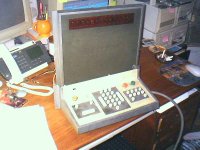MikeS
Veteran Member
Duh! ;-)Well as that picture came from my website and yes it is the UTAS B6700
How's the System 3 coming along?
| VCF West | Aug 01 - 02 2025, | CHM, Mountain View, CA |
| VCF Midwest | Sep 13 - 14 2025, | Schaumburg, IL |
| VCF Montreal | Jan 24 - 25, 2026, | RMC Saint Jean, Montreal, Canada |
| VCF SoCal | Feb 14 - 15, 2026, | Hotel Fera, Orange CA |
| VCF Southwest | May 29 - 31, 2026, | Westin Dallas Fort Worth Airport |
| VCF Southeast | June, 2026 | Atlanta, GA |
Duh! ;-)Well as that picture came from my website and yes it is the UTAS B6700
Yeah, that was the big thing for the software guys to recompile the MCP and put the company logo in the idle loop. Mine said "AC" most of the time. I remember one time they were upgrading the MCP and wanted it to be obvious they were on the new vesion. So they put the logo in "negative video". I was not happy ;-) being the one who had to change the bulbs.The CPU & memory cabinets alone took one entire wall of a fairly large room, and it had the most impressive panel of blinkenlights I've ever seen; it was in house for a couple of months being tested and set up for the Metro Toronto police department, and when idle it displayed the MTP crest on its panel of lights which ISTR was about 3 feet square; those bulbs alone probably would have heated one or two small rooms...
The B6700 hardware manual lists several other voltages too: for the core-memory system there are +1V, -50V, +63V and +37V. In another part of the CPU/DCP system there are also +12V and -12V - the power supplies must have been quite complex to supply so many different voltages.
Burroughs appear to have their own logic integrated circuits listed as CTuL (Complimentary Transistor Micro Logic), they were positive logic, "true" was +2.5V and "false" was -0.5V
Jim: do you happen to remember what was special about the B6748 "restricted model"? it is not listed in the reference manual I have but I found another reference to it in Doran's book.

2012 or bust!How's the System 3 coming along?
Jim - can I use this picture on my website please? it is particularly interesting as it shows a dual CPU configuration.
2012 or bust!
I'm running out of excuses, but for 2012 I want to get the Cromemco System 3 (Cromix), LDP-88 (UCSD p-System), and PDP-8/E (EduSystem) functional.
Jim - can I use this picture on my website please? it is particularly interesting as it shows a dual CPU configuration.
But was it possible to have both displays connected to the same CPU? I guessed it was dual CPU since both are displaying the idle MCP "B"urroughs light-pattern so I assumed two different CPUs.It has dual maintenance displays... I never really noticed that before. That wasn't necessary for a dual CPU configuration. The panel could be switched to any CPU or I/O processor.
Definitely bigger than the one we had...But was it possible to have both displays connected to the same CPU? I guessed it was dual CPU since both are displaying the idle MCP "B"urroughs light-pattern so I assumed two different CPUs.
But was it possible to have both displays connected to the same CPU? I guessed it was dual CPU since both are displaying the idle MCP "B"urroughs light-pattern so I assumed two different CPUs.
Definitely bigger than the one we had...
Are those TD800s? I sold mine long ago, but still have a keyboard somewhere; should use that for something.

It has dual maintenance displays... I never really noticed that before. That wasn't necessary for a dual CPU configuration. The panel could be switched to any CPU or I/O processor.
...Funny now, 35 years later, but embarassing then...
What a great story! do you have any photographs from that era you can share?
